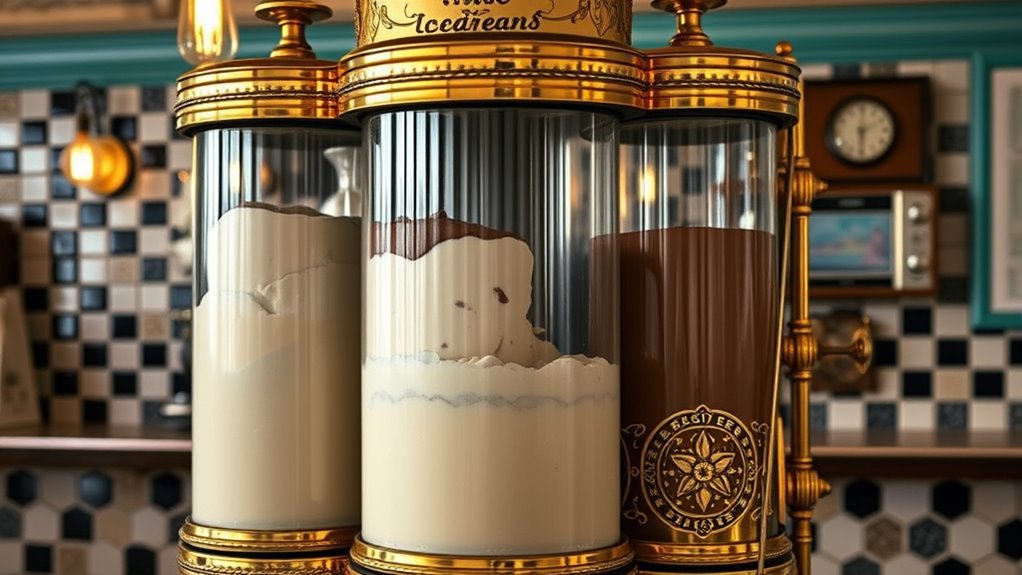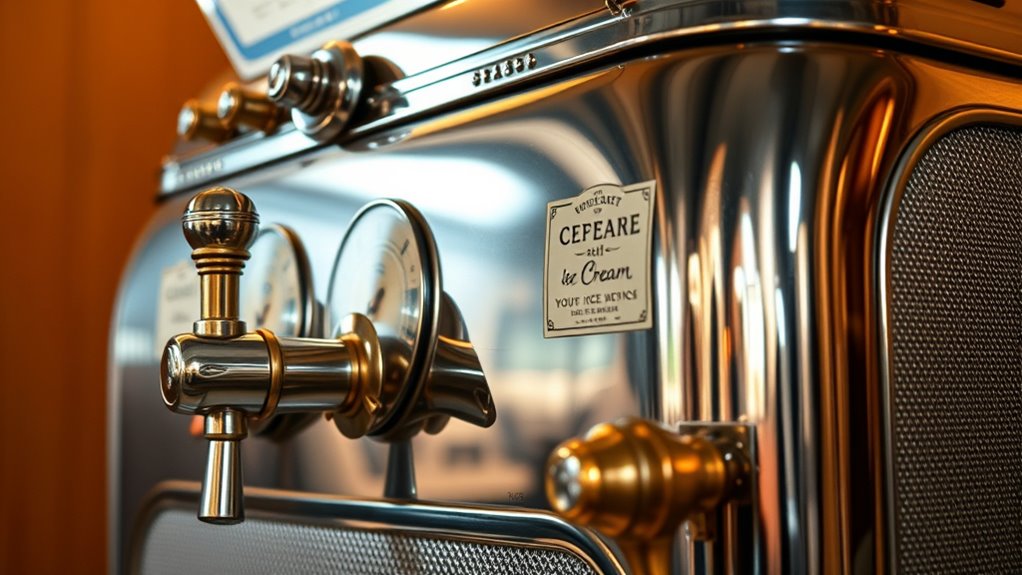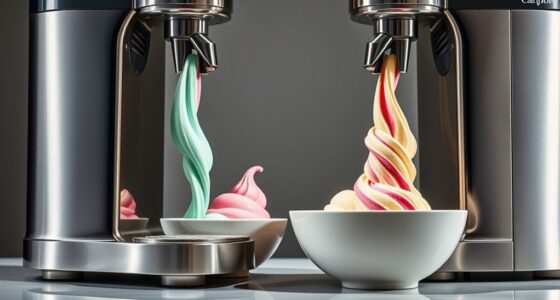The history of commercial ice cream machines is a story of early manual churning evolving into advanced automation. From bulky hand-crank churns of the 1800s to modern computer-controlled systems, technological innovations have made ice cream production more efficient and accessible. Refrigeration and automation transformed the industry, enabling large-scale manufacturing and everyday availability. Ongoing innovations in energy efficiency and hygiene continue to shape the industry—if you keep exploring, you’ll discover how these advancements revolutionized your favorite treat.
Key Takeaways
- Early ice cream machines relied on manual hand-cranks and basic mechanical processes, limiting scale and efficiency.
- The development of compressor-based refrigeration enabled larger production and automation in ice cream manufacturing.
- Manufacturing innovations made machines more affordable, compact, and accessible for small businesses and vendors.
- Recent advances include energy-efficient components, digital controls, and improved sanitation features for better performance.
- Continuous freezers and soft-serve machines revolutionized the industry, reflecting ongoing technological progress.

The history of commercial ice cream machines is a fascinating journey that reflects both technological innovation and changing consumer tastes. Early on, these machines were simple devices that relied on manual or basic mechanical processes, but over time, they evolved considerably, driven by advancements in technology and manufacturing processes. As you explore this history, you’ll notice how each innovation was aimed at improving efficiency, consistency, and quality, making ice cream more accessible and enjoyable for the masses. The development of microprocessors and specialized hardware played a crucial role in modernizing these machines, enabling precise control and automation. Initially, ice cream making was a labor-intensive process, often done by hand or with rudimentary equipment. But as the 19th century progressed, inventors began experimenting with mechanical refrigeration and motor-powered systems. This marked the beginning of the technology evolution that would transform the industry. The introduction of the hand-crank churns in the early 1800s allowed for more uniform freezing, but it was still limited in scale and speed. As technology advanced, automatic machines with compressor-based refrigeration systems emerged, allowing larger quantities of ice cream to be produced more quickly and with less manual effort. These innovations not only increased production capacity but also improved the consistency of the final product. Additionally, the integration of advanced manufacturing techniques helped reduce costs and improve reliability of the equipment. Moreover, the development of standardized parts contributed significantly to the ease of repair and maintenance, further supporting widespread adoption. The manufacturing processes behind commercial ice cream machines also saw a major shift during this period. Early models were often bulky and expensive, limiting their use to large factories or upscale establishments. However, as manufacturing techniques improved, machines became more compact, affordable, and durable. The development of standardized parts and mass production methods meant these devices could be produced at scale, making commercial ice cream equipment accessible to a broader market. This democratization of technology helped spur growth in the ice cream industry, enabling small businesses and even mobile vendors to operate efficiently. Furthermore, the incorporation of energy-efficient components has become a key focus in recent innovations, reducing operational costs and environmental impact. As manufacturing processes advanced, automation technology began to be integrated into these machines, further refining their capabilities. Throughout the 20th century, further innovations such as continuous freezers and soft-serve machines emerged, revolutionizing the way ice cream was produced and served. These advancements were made possible by ongoing improvements in manufacturing processes, allowing for more specialized and efficient equipment. Today, modern commercial ice cream machines incorporate digital controls, energy-efficient compressors, and advanced sanitation features, all developments rooted in decades of technological evolution and refined manufacturing practices. As you look at today’s machines, you’ll see how far they’ve come, embodying a blend of engineering precision and user-friendly design that continues to meet consumer demands. This history demonstrates how technological progress has continually pushed the boundaries of what commercial ice cream machines can achieve, shaping the industry into what it is today.
Frequently Asked Questions
How Do Commercial Ice Cream Machines Maintain Consistency in Flavor?
You guarantee flavor stability and ingredient consistency by regularly calibrating your commercial ice cream machine. Precise temperature control and consistent mixing speeds prevent flavor variations, maintaining a uniform taste. Using high-quality ingredients and following standardized recipes also help. Regular cleaning prevents contamination, and monitoring the machine’s performance ensures it operates at its best. All these steps work together to deliver a consistent, delicious product every time, satisfying your customers.
What Innovations Have Improved the Efficiency of Ice Cream Machines?
You’ll find that innovations like automated controls and energy-efficient compressors have substantially boosted ice cream machine efficiency. Automated controls help you maintain precise temperatures and streamline operation, reducing downtime. Energy-efficient compressors lower power consumption while ensuring consistent cooling, which saves costs and improves performance. These advancements make your machine more reliable, faster, and sustainable, helping you serve high-quality ice cream efficiently and with less effort.
How Do Different Types of Machines Impact Ice Cream Texture?
You’ll notice that different ice cream machines impact texture through factors like dairy blend and machine calibration. For instance, over-calibrated machines can produce smoother ice cream, while under-calibrated ones might result in a grainier texture. The dairy blend’s fat and sugar content also influence creaminess. By adjusting these variables, you control ice cream’s final texture, ensuring it’s perfectly creamy or invigoratingly icy, depending on your preference.
What Are the Environmental Impacts of Commercial Ice Cream Machines?
Imagine the environmental impact of commercial ice cream machines is massive! These machines consume significant energy, often relying on high energy consumption that can drain power grids. But, by switching to sustainable refrigerants, you can drastically reduce harmful emissions. You have the power to make a difference by choosing eco-friendly options, helping to protect our planet while still serving delicious ice cream. Every small change counts!
How Has Maintenance Technology Evolved for These Machines Over Time?
You’ve seen how maintenance tech has evolved for commercial ice cream machines. Today, you benefit from automated diagnostics that quickly identify issues, reducing downtime. Predictive maintenance now predicts parts failure before it happens, saving you money and preventing disruptions. This shift means you spend less time on manual checks and more on keeping your machines running smoothly, ensuring consistent quality and efficiency in your operations.
Conclusion
Now, as you savor your favorite scoop, remember you’re enjoying a marvel that’s evolved over centuries—once imagined by Leonardo da Vinci as a magical device. From ancient ice pits to state-of-the-art machines, each innovation brought joy to countless people. So, next time you hear the hum of a commercial ice cream machine, appreciate its fascinating journey through time, blending history and innovation, just like a scene from an old-fashioned carnival. Truly, it’s a sweet affirmation to human ingenuity.










